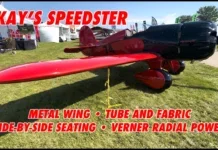First time visitors to EAA AirVenture predictably utter the standard pronouncement, “I had no idea it was so BIG!” I always try to prepare inductees for the magnitude of the operation, but it never takes hold until they’ve worn themselves out at the end of the first full day of walking the grounds. Invariably, with their appetite for aviation, they try to see it all in one continuous Ironman competition. And they will pay dearly for it.
I tried to tell ‘em—pace yourself. You’ll never see it all, even if you stay the week, so pick your must-sees and come back next year for the rest. Learning how to manage your capacity for abuse is a necessary part of the Oshkosh experience.
 At its core, it’s a walking show. You will need more than one pair of comfortable shoes to alternate daily. Take care of your feet, with cushiony socks, massages, and bandages if necessary. You can spot those who haven’t done so, by their slow, deliberate steps, teeth gritted, as they move between frequent rest stops. When the grounds are crowded, typically on Tuesday or Saturday, the people-mover trams will be saturated with immobile riders packed cheek to cheek, leaving the queued-up left-behind hopefuls with no option but to hoof it.
At its core, it’s a walking show. You will need more than one pair of comfortable shoes to alternate daily. Take care of your feet, with cushiony socks, massages, and bandages if necessary. You can spot those who haven’t done so, by their slow, deliberate steps, teeth gritted, as they move between frequent rest stops. When the grounds are crowded, typically on Tuesday or Saturday, the people-mover trams will be saturated with immobile riders packed cheek to cheek, leaving the queued-up left-behind hopefuls with no option but to hoof it.
When I started coming to Oshkosh in the early 1970s, it was much more manageable, albeit with spartan facilities. Everything was strung out along Wittman Road, the north-south pathway paralleling runway 18/36, including the forerunner of the iconic Brown Arch, backed up by the old control tower. The North 40 campgrounds were about where Warbirds parking is now located; back then, what is presently the Warbirds showerhouse provided the only amenities for airplane campers. Most homebuilts were parked north of the control tower, between the north-south taxiway and the main thoroughfare, and the vintage crowd congregated to the south. Commercial exhibits were crowded into tents or the low-ceiling metal buildings along the west side of Wittman Road. Walking the show was doable.
As more and more exhibitors and enthusiasts flooded into the public and private spaces, expanding steadily westward in layers of encroachment, getting around the grounds became strenuous. EAA Chapters volunteered to build tractor-pulled trams, initially designated for disabled and elderly attendees, but these were gradually expanded in capability to accommodate all comers. The shuttles are lifesavers to the foot-weary, but in peak times you must always be prepared do it on your own. Pay attention to the colored flags on the tram when boarding at a terminus point, to be sure you’re going to be taken in the desired direction.
If roaming farther afield, you’ll find summer-fallowed school buses used to circle the North 40 aircraft parking, making random stops. Similar buses will take you to the seaplane base and EAA museum, both providing a restful break from the show. If you’re making trips to Fond du Lac and Appleton airports, for those who opted out of the beehive at Wittman Field, or if catching the city bus into town for the University dormitories, you must find your way west along Waukau Avenue to the Bus Park. Be aware of “last bus” departure times if you’re staying late.
For orientation, keep an eye on the tall Control Tower at the corner of Waukau and Knapp; if separated from your party, try rejoining near the Tower, the adjacent flagpole, or the trees by the nearby food court. It’s easy to get confused among the displays and exhibits, especially those on diagonal pathways.
Plan your travels to minimize extra walking. If you’re taking the seaplane base diversion, note that the bus makes stops at the South 40 near the Ultralight area as well as the Bus Park. If you’re wanting to visit the Warbirds or seminar presentations, use the North 40 Shuttle. Never retrace your steps, unless you’re a mission-oriented journalist.













